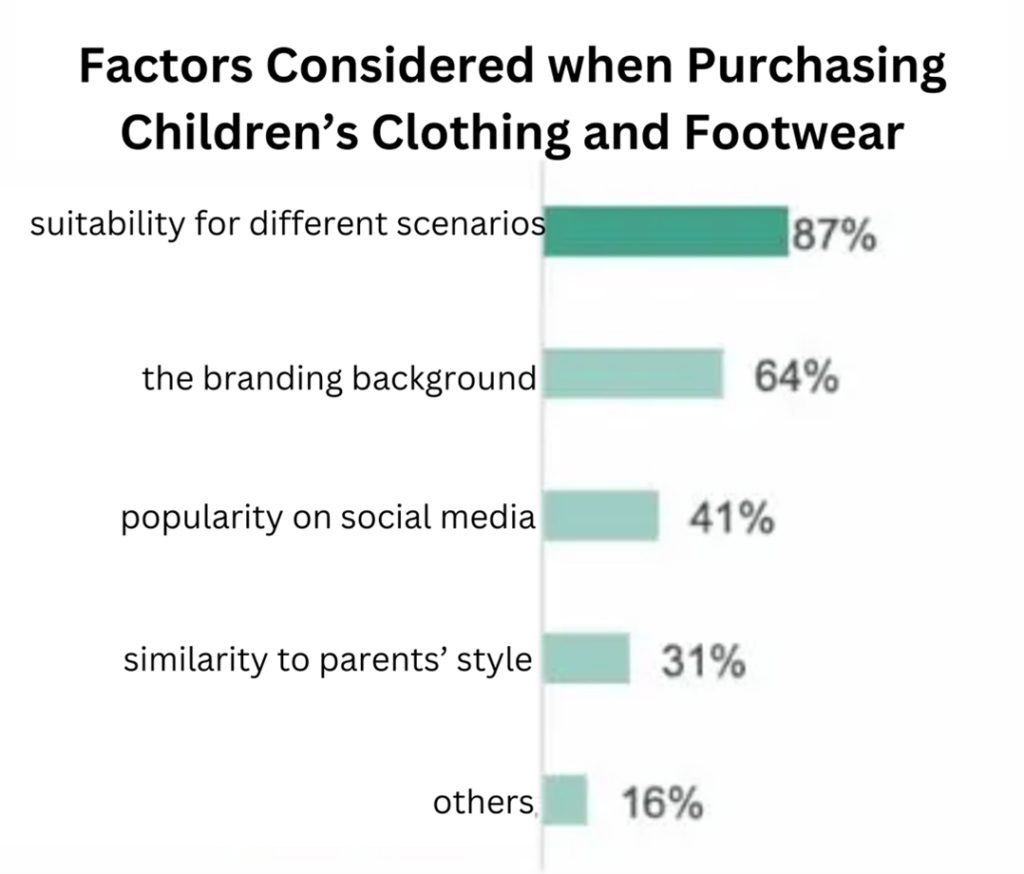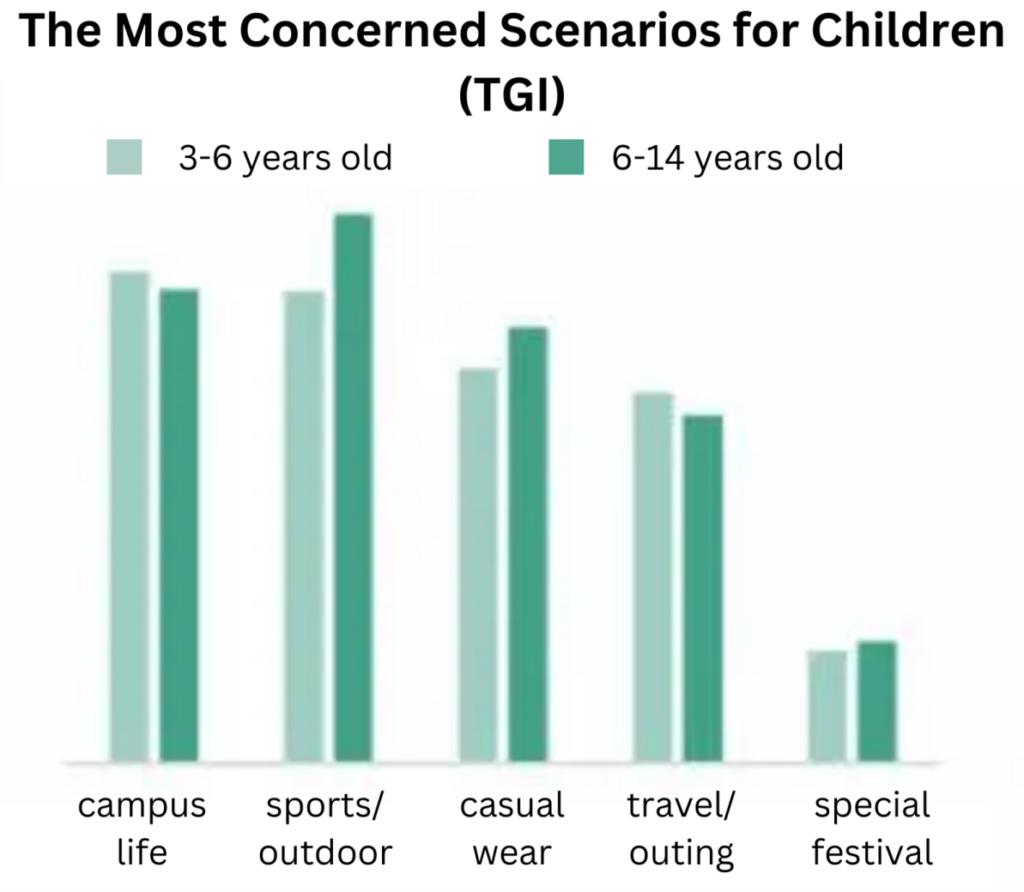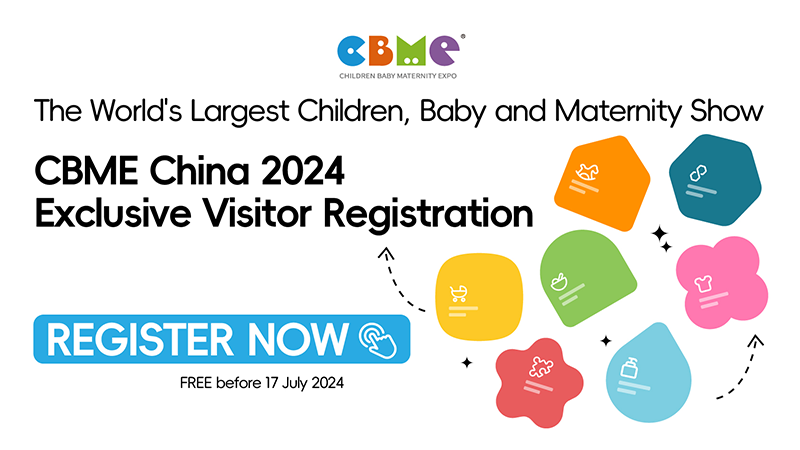1. Overview of the Chinese Children’s Wear Market
1.1 Definition of Children’s Wear
Children’s wear refers to a diverse range of clothing and footwear specifically designed for children of various ages. This category is broadly classified into two main segments: children’s clothing and children’s footwear. These products are meticulously tailored to meet the unique size, comfort, and style requirements of children at different developmental stages, from infants to teenagers.
Children’s Clothing: This segment encompasses an extensive array of garments, including tops, bottoms, dresses, outerwear, sleepwear, and accessories. The age groups covered include:
- Babies (0-3 years): Focused on comfort and ease of dressing.
- Kids (4-12 years): Designed for active lifestyles and play.
- Teenagers (13-18 years): Fashion-forward options that reflect personal style and current trends.
Children’s Footwear: This category includes shoes crafted for children across all age groups, emphasizing essential factors such as proper foot size, comfort, and safety. Footwear designs often incorporate features that support growing feet, ensuring both style and functionality.
To ensure suitability for their intended age groups, children’s wear products must adhere to stringent safety standards and regulations, offering parents peace of mind.
1.2 China Children’s Wear Market Size
The Chinese children’s wear market was valued at approximately USD 53.92 billion in 2023. Projections indicate that this figure will soar to USD 79.66 billion by 2028, reflecting a robust CAGR of 8.12% during the forecast period (2023-2028). This rapid growth is primarily driven by a large potential customer base characterized by China’s massive population and a steadily increasing middle-class demographic, which is becoming increasingly focused on quality and brand when selecting children’s clothing .

| 2023 Market Size | 2028 Market Size | CAGR (2023-2028) | |
| China Children’s Wear Market Size | USD 53.92 billion | USD 79.66 billion | 8.12% |
Source: Childrenswear Market Size & Share Analysis – Growth Trends & Forecasts (2024 – 2029) By MordorIntelligence[JS1]
2. Current Situation of the Chinese Children’s Wear Market
2.1 Expansion of the Older Children Market
In recent years, the population of children aged 0-14 in China has seen a steady increase, growing from 224 million in 2013 to 239 million in 2022. However, due to an annual decline in the birth rate, it is anticipated that the population of infants and young children may decrease in the near future. Notably, while the baby and toddler segment may experience a decline, the market for older children (aged 7-16) is expected to maintain stable growth. This is attributed to the residual effects of higher birth rates in previous years, indicating that the demand for children’s clothing and footwear will persist.

Source: CWE Report 2023-2024[JS2]
2.2 Increasing Demands for Special-Scenario Clothing
Scenario-based dressing has emerged as a pivotal trend in the children’s wear market. Parents now prioritize the suitability of clothing for various scenarios when selecting outfits for their children. This shift emphasizes the need for different styles and functionalities tailored to specific activities and events in a child’s life.
From the crucial phase of learning to walk to the dynamic experiences of kindergarten and elementary school, and extending into the social activities of teenagers, each stage requires clothing that fits not only in style but also in functionality. Key areas witnessing notable growth include:
- Outdoor Clothing: Gear designed for active play and exploration.
- Swimwear: Specialized swim gear catering to water activities.
- Formalwear and Festival Attire: Dressy options for special occasions, which have gained popularity as parents increasingly want their children to dress well for social events.

Source: Taobao Report 2024[JS3]

Source: Taobao Report 2024[JS4]
3. Future Trends of the Chinese Children’s Wear Market
3.1 Lifted Quality & Safety Requirements
As living standards improve, parents’ expectations for children’s wear extend beyond basic functional needs. Today’s consumers are increasingly focused on quality and safety, demanding products made from environmentally friendly materials and compliant with rigorous safety standards. This trend necessitates a shift in production and design practices within the children’s wear sector, as brands strive to meet these elevated expectations.
3.2 More Pronounced Branding Effect
The popularity of branded children’s wear continues to rise. Parents often prefer products from well-known brands, perceiving them as more reliable in terms of quality assurance and after-sales service. This trend underscores the importance of branding and reputation in driving consumer choices within the children’s clothing market.
3.3 More Precise Market Segmentation
The children’s wear market is increasingly focusing on precise market segmentation, addressing the specific needs of different age groups and occasions. Brands are introducing a variety of styles and functional clothing products tailored to the unique requirements of babies, young kids, and preschoolers. Additionally, specialized clothing for activities such as sports, swimming, and outdoor adventures is becoming more prevalent, catering to parents seeking high-performance options for their children .
3.4 Continuous Expansion of Product Categories
The children’s wear market is evolving towards diversification. Beyond traditional clothing items, brands are now introducing various accessories, toys, and related products that cater to the diverse interests and needs of children. This trend not only enriches the product offerings but also provides new avenues for growth within the children’s wear sector.
Conclusion
In summary, the Chinese children’s wear market is on a promising trajectory, driven by demographic shifts, changing consumer preferences, and a focus on quality and safety. With continuous innovations and expansions in product categories, there are abundant opportunities for brands to tap into this lucrative market. For retailers and brands looking to thrive in this sector, understanding these trends and adapting to consumer demands will be essential for sustained growth.
#Plush Toy Fair baby and toddler soft toys
#Plush Toy Fair therapeutic plush toys for comfort
#Plush Toy Fair custom plush toy manufacturers
#Plush Toy Fair plush toy material safety Plush Toy Fair interactive plush toys






